INSTRUCTIONS TO CANDIDATES:
- Write your name, name of your school and index number in the spaces provided.
- Sign and write date of examination in the spaces provided above.
- Answer all the questions in the spaces provided.
- This paper consists of 8 printed pages. Candidates should check to ascertain that all the pages are printed as indicated and that no questions are missing.
For Examiner's Use Only:
| QUESTIONS | MAXIMUM SCORE | CANDIDATES SCORE |
| 1-27 | 80 |

QUESTIONS
- A Lander on Mars discovered a "thing that can move, feed, respond to stimuli and excrete but does not reproduce and grow. Can it be considered as a living thing? Why? (2 marks)
- Study the diagram below and answer the question that follow:
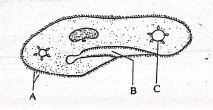
- Name the kingdom from which the organism belongs to. (1 mark)
- State the function of the structure labelled C. (1 mark)
- The diagram below shows the type of epithelial tissue.
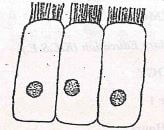
- Name the hair-like processes. (1mark)
- State the function of the hair-like process. (1 mark)
- Liver damage leads to impaired digestion. Explain. (2 marks)
- In an experiment, students added saliva in a test tube containing starch solution. After 30 minutes they tested the mixture for starch and the result was negative. Students added this mixture into another test tube containing starch solution. After another 30 minutes they tested the final mixture for starch.
-
- What were the students trying to prove with this experiment? (1 mark)
- What is the expected result of the second starch test? (1 mark)
- Why did the students waited for 30 minutes each time to test for starch? (1 mark)
-
- The blood smear image below shows the appearance of red blood cells after the blood was mixed with a certain salt solution.
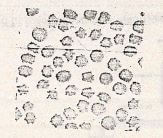
- What is the nature of the solution? (1 mark)
- Explain why blood cells appear as seen in the image. (2marks)
- The diagram below represents blood circulation in a fish.
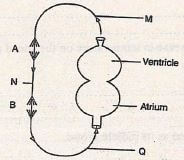
- Name the parts of the fish represents by blood capillary network A and B. (2marks)
- ..................................
- ..................................
- State two ways in which the above circulatory system differs from the one found in mammals. (2marks)
- State one advantage of double circulation over simple circulation. (1mark)
- Name the parts of the fish represents by blood capillary network A and B. (2marks)
-
- Define guttation. (1 mark)
- State the significance of guttation in plants. (1 mark)
- How is support attained in herbaceous plant? (1 mark)
- A setup that was used to investigate a certain process in plants is shown in the diagram below.
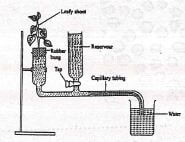
- What is this apparatus used for? (1mark)
- State and explain the observation made when the apparatus was set-up on a mountain. (2 marks)
- What would be the effect of a slight increase in temperature on the speed and direction of the air bubble in the capillary tubing? (1 mark)
- The diagram below shows a germinating seed as its radicle grows.
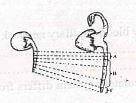
- Name the zones labelled B and C. (2 marks)
B.........................
C......................... - Name the type of tissue found in the zone C and state a characteristic of it. (2 marks)
- Name the zones labelled B and C. (2 marks)
- In bony fish, water flows along the gill lamellae in a direction opposite that of the flow of blood.
-
- Name the phenomenon described. (1 mark)
- Explain how this phenomenon you named in (a) (i) above works. (2marks)
- Name an organ in human beings that the same phenomenon occurs. (1 mark)
-
- The diagram below show two different organisms belong to the same class.

- Name the class to which organisms belong. (1 mark)
- State two features that can be used to place the organism in the class named in (a) above. (2 marks)
- Form two students set up an experiment as shown below.
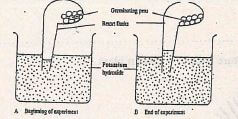
- Explain the change observed at the end of the experiment. (2 marks)
- Explain what would happen if water was used instead of potassium hydroxide. (2 marks)
- Explain why fresh water protozoa like amoeba do not burst when placed in distilled water. (2 marks)
- When the environmental temperature is very high, some animals urinate on their legs or lick the sides of their body. How does this help in temperature regulation? (2marks)
- Considering their diets are similar, who would excrete more urea: a person who exercises frequently or the one who does not? Explain. (2marks)
-
- Describe the term bio-indicator with an example. (2marks)
- Give an example of biological control. (1 mark)
- The diagram below represents a stage in cell division.

- Identify the stage of cell division. (1 mark)
- Give a reason for your answer. (1 mark)
- The diagram below represents a mature fruit of a certain plant.
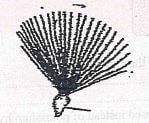
- State the agent of dispersal for the fruit. (1mark)
- Give a reason for your answer in (a) above. (1 mark)
- State two other characteristics of fruits and seeds dispersed by the agent you have named in (a) above. (2marks)
- What are the advantages of fruit and seed dispersal? (2marks)
- State the agent of dispersal for the fruit. (1mark)
- Describe how fraternal twins are formed. (2 marks)
- The diagrams below represent a young root tip and four cells which occur in the different regions of the root tip labelled K, L, M and N.
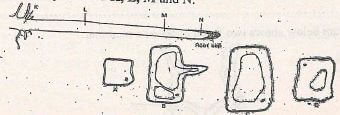
State the region of the root tip where each of the cells A, B, C and D occur (4 marks)
Cell region of the root tip- ..............................
- ..............................
- ..............................
- ..............................
- A certain animal had one cell from its alimentary canal observed under a light microscope. A total of 40 chromosomes were seen.
- State the number of chromosomes in:
- The spermatozoon of this animal. (1mark)
- One of the cells of the tongue. (1 mark)
- What is meant by the term allele? (1 mark)
- State the number of chromosomes in:
- Two populations of the same species of birds were separated over a long period of time by an ocean. Both populations initially fed on insects only. Later it was observed that one population fed entirely on fruits and seeds. Although insect were available. Name this type of evolutionary change. (1 mark)
- Nocturnal animals such as the owl are capable of seeing fairly well at night. What two retinal adaptations have made this possible? (2marks)
- The diagram below shows an experiment performed on oat coleoptiles. Three potted seedlings labelled R, S and T were treated as following:
R-tip was covered with aluminium foil cap.
S-tip of the coleoptiles was decapitated.
T-tip was left intact.
The seedlings were covered with a box, which had a hole on one side and painted black on the inside. The setup was left for 2 days.- State the expected observations for each of the seedlings. (3marks)
- Explain the observation for the seedling labelled R. (1mark)
- The diagram below shows two fused bones of a mammal.
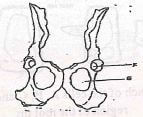
- Identify the fused bones (1 mark)
- Name the:
- Bone that articulates at the point labeled F. (1 mark)
- The hole labeled G (1 mark)
- The diagram below represents bones at a joint found in the hind limb of a mammal.
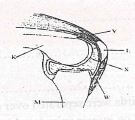
- Name: (2marks)
- the bone L
- the fluid labelled X..
- Name the type of the joint (1 mark)
- Name: (2marks)

MARKING SCHEME
- Non-living; has to posses all characteristics of living things for it to be considered a living thing;
-
- Protoctista;
Rej- Starting with a small letteri.e. protoctista)
- Wrong spelling
- Osmoregulation;
- Protoctista;
-
- Cilia; Rej-Singular - Wrong spelling
- To waft zygote from the oviduct/fallopian tube to the uterus// waft trapped dust particles away from the lungs towards the pharynx;
- This leads to lack of bile juice/salts hence no digestion of fats/oils/lipids because emulsification of fats/oils/lipids does not occur;
-
-
- Enzymes can be re-used (during enzyme controlled reactions);
- Negative/Starch absent;
- To give time for enzyme (salivary) amylase/ptyalin to digest/break down starch;
-
-
- Hypertonic (solution);
- Salt solution was hypertonic to the cytoplasm of red blood cells/erythrocytes and the cells lost water molecules by osmosis; the cells shrank and became crenated;
-
- A-Gills:
B-Body tissues; Rej - Body alone -
Circulation in fish Circulation in mammals 1 Single circulation/blood flows through the heart once in every complete circulation Double circulation blood flows through the heart twice in every complete circulation; 2 Blood flows under low pressure Blood flows under high pressure;
- A-Gills:
-
- Process by which plants lose water in form of water droplets from hydathodes when there is high humidity:
- Enables plants in high humid areas to lose excess water; (c) Tightly packed parenchyma cells gain water by osmosis and become turgid:
-
- Measure the rate of transpiration;
- Air bubble moves faster (towards the left/leafy shoot); On the mountain there is low atmospheric pressure hence high rate of transpiration;
- The air bubble moves faster towards the left/leafy shoot;
-
- B-Zone of cell elongation; C-Zone of cell division;
- Meristematic tissue;
- They are small;
- have dense cytoplasm; Award any one
- Are thin walled;
-
-
- Counter-current flow;
- Blood and water moves in the opposite direction within the respiratory surface oxygen diffuses out of the water into the blood in the gills) and carbon (IV) oxide diffuses out of the blood in the gills into the water, this is due to the steep concentration gradient created by the counter-current flow;
- Kidney placenta;
-
-
- Arachnida;
-
- Has four pairs of legs;
- Presence of cephalothorax;
- Presence of pedipalps;
- Presence of chelicerae;
Note: - Award only first two
- (b) is tied to (a)
-
- Germinating seeds respire using up oxygen in the retort flask producing carbon(IV) oxide; which dissolves in potassium hydroxide creating a partial vacuum taken up by potassium hydroxide solution;
- There will be no rise in level of water; because carbon(VI) oxide is not soluble in water hence the volume in the flask does not change;
- Amoeba has contractile vacuole; which excrete excess water;
- As moisture from urine or saliva evaporates from the surface of the skin; it absorbs latent heat of vaporization from the body thus cooling:
- A person who does not exercise will excrete more urea; because the person exercising uses more amino acids to build muscles thus less will be deaminated excreting less urea;
-
- A bio-indicator is any (group of) species whose function/population/status reveal the qualitative status of the environment; Absence of Lichens indicates pollution/absence of frogs in small water bodies indicate presence of chemical;
- Introducing cats to control the population of mice/rats;
- Ladybird to control pests of citrus fruits/cottony-cushion scale pest;
- Wasps to control aphids;
-
- Metaphase 1;
- Chromosomes align themselves at the couator;
-
- Wind; Rej- Wind dispersal
-
- Has pappus/hair-like sructures;
-
- Light in weight;
- Has wing-like structures; (c)
- Avoid competition/overcrowding:
- Colonisation of new areas:
- Fraternal twins are formed when two eggs/ova are released at the same time; each of the eggs gets fertilized by separate sperm and develops successfully into a foetus;
-
Cell Region of root tip A N;B K;C L D M
-
-
- 20 chromosomes;
- 40 chromosomes;
- Alternative forms of a gene controlling a particular characteristic/trait;
-
- Divergent evolution;
- Have numerous rods in the retina; which contain rhodopsin adapted for vision in dim light;
-
- R - The coleoptile will grow straight upwards;
S-No growth takes place;
T- The coleoptiles will grow and bend towards light; - The aluminium foil cap prevents light from one side from causing auxins at the tip of the coleoptile to migrate to the side away from light hence the shoot continues growing straight upward;
- R - The coleoptile will grow straight upwards;
-
- Pelvic girdle;
-
- Femur:
- Obturator foramen; Rej- Wrong spelling
-
-
- L -Patella;
- Synovial fluid;
- Hinge joint;
-
Download Biology Paper 1 Questions and Answers - Sukellemo Joint Mock Examinations July 2020.
Tap Here to Download for 50/-
Get on WhatsApp for 50/-
Why download?
- ✔ To read offline at any time.
- ✔ To Print at your convenience
- ✔ Share Easily with Friends / Students

